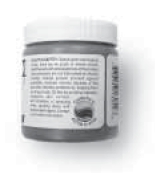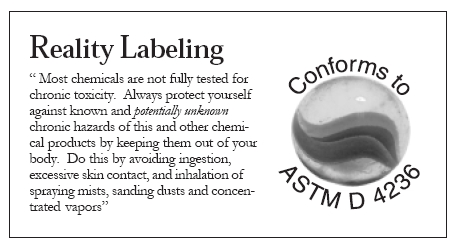A new Health & Safety format will soon begin to appear on GOLDEN labels. This year, we will be phasing out the use of the ACMI AP and HL Seals on our labels and putting a finer edge to the wording in the section on Health & Safety advice. We are introducing a new icon for products that do not pose a significant health risk when evaluated according to ASTM D 4236. It acknowledges three things: First, potentially toxic chemicals are likely present at some level regardless of risk assessment; second, it is inappropriate to assume that all possible chronic hazards of chemicals are currently known; and Third, personal exposure should be prevented when using the product. The new icon is a facsimile of a playing marble. It was chosen to symbolically represent art materials that should be taken away from anyone who puts them in their mouth.
Risk Assessment?
For years, federal law has required that toxicologists evaluate art materials and appropriately label them with warnings for any potential acute or chronic health hazards. This evaluation is performed according to the guidelines of ASTM D 4236, Standard Practice for Labeling Art Materials for Chronic Health Hazards. The assessment uses factors such as chemical form and concentration, anticipated frequency and duration of use, and bioavailability1 of the chemical.
This mathematical process necessarily relies upon the use of averages and assumptions, as well as significant compensating safety factors. It boils down to whether the nature of the process is such that there is room for debate over many of the individual factors used. The result is that different opinions may arise as to the relative toxicity of a material. These are complex issues and there is validity in more than one opinion.
Toxicological assessment can only rely upon current scientific and medical knowledge of chemical hazards. Although ASTM D 4236 states that “ knowledge about chronic health hazards is incomplete”, we have seen the leap made from the “absence of known hazards” to the declaration that a product is “non-toxic” under this Standard. We do not believe these phrases mean the same thing and our new labels reflect this.
California Warnings
Recently some citizens of the State of California became concerned that art materials contain chemicals that are listed in the California Safe Drinking Water and Toxic Enforcement Act (otherwise known as Proposition 65) as being known to cause cancer and/or reproductive toxicity. If chemicals on these lists are in products sold in California, the product label is required to provide clear and reasonable warning to that effect. The Act exempts products that do not pose a significant risk from the labeling requirement. However, as described above, “significant risk” is debatable. The result is that we have consented to apply warnings, regardless of relevant risk assessments, to all products which contain any Prop 65 –listed chemicals, where such are listed as ingredients on the product’s Material Safety Data Sheet and/or label. These labels were in place for shipments leaving our facility after October 6, 2000.
Chemicals on the Prop 65 Lists include cobalt, nickel compounds, cadmium compounds, chromium, lead and crystalline silica. For products containing these chemicals, we have agreed to label with the phrase “WARNING: This product contains a chemical known to the State of California to cause cancer” (or “reproductive toxin” or both).
For fourteen years we have been a member of the Art and Creative Materials Institute (ACMI), and have displayed their globally recognized “AP” seal on GOLDEN products that, according to toxicological evaluation, pose no significant risk to the user. It has been through the use of the ACMI AP and Health Label (HL) Seals that consumers have been able to quickly differentiate between products that do and do not pose significant known risks. However, the AP seal has become well known as representing a “non-toxic” product and would conflict with California Prop 65 warnings. We have also chosen not to label these products with the ACMI HL Seal, which has been traditionally used on products requiring warnings under federal law, based on toxicological risk assessment. Therefore, after careful consideration, we have chosen a separate path and will be phasing out use of the ACMI seals. All products will continue to be evaluated by a board-certified toxicologist and will continue to verify this assessment on the label, by including the phrase “Conforms to ASTM D 4236”.
X Means Harmful
Products deemed to present a significant risk under conditions of foreseeable use, based upon Federal guidelines (ASTM D 4236), will now carry the European icon for a harmful product, which is a prominent black X on an orange background. All GOLDEN cadmium colors will be included in this group in order to better draw attention to the fact they should not be spray applied. This change will more closely align these products with the Occupational Safety and Health Administration’s risk analysis of cadmium compounds.
It’s A Better Label
We have always believed that people have a right and need to know what chemicals they are working with, and that they should follow basic precautions when using any of our products. This approach has been reflected on our labels, which give pigment identification information and general guidelines for safe use, and on our Material Safety Data Sheets (MSDS) which list hazards of product components without incorporating the use assumptions of toxicological risk assessment. The changes we are now undertaking will reemphasize the need to err on the side of caution when using art materials. At the same time, we will reinforce this message by explaining why. It’s a lot of information to fit onto a label, but we believe it’s the best we can offer. For more information, contact Ben Gavett, Director of Safety and Compliance.
1 bioavailability is the extent that a substance can be absorbed in the body in a biologically active form.
About Golden Artist Colors, Inc.
View all posts by Golden Artist Colors, Inc. -->Subscribe
Subscribe to the newsletter today!
No related Post



This new labeling format is a huge win for clarity and safety! The standardized pictograms and hazard statements will make it so much easier to quickly identify risks and handle materials properly. Thanks for breaking down these important updates
We are glad you find the new labeling useful. Thank you for the feedback!